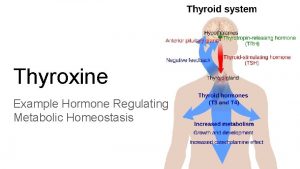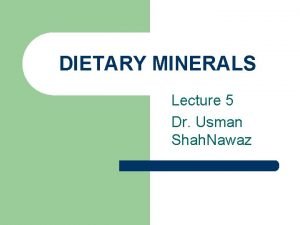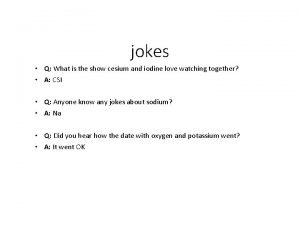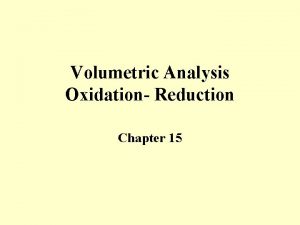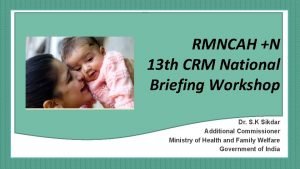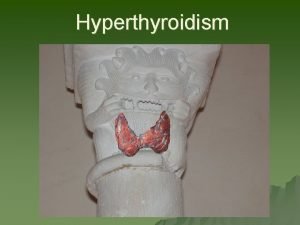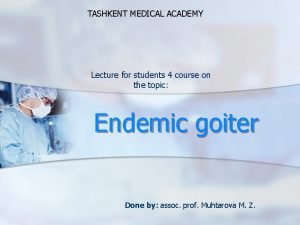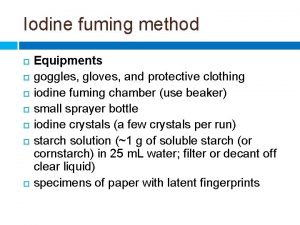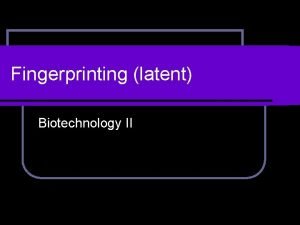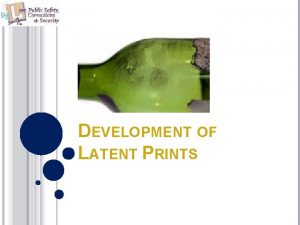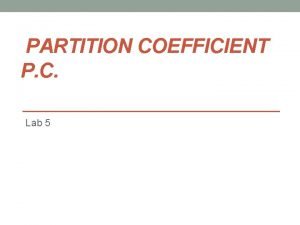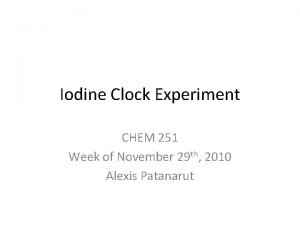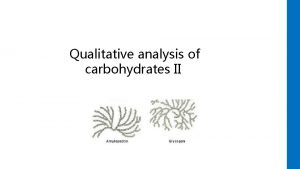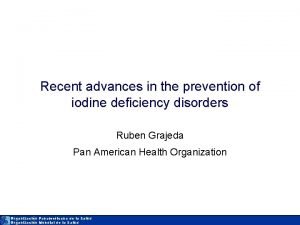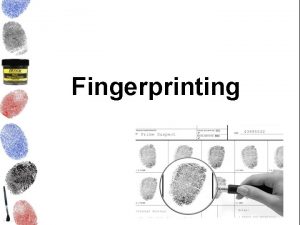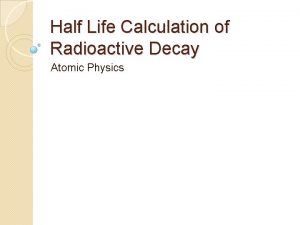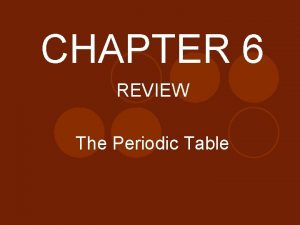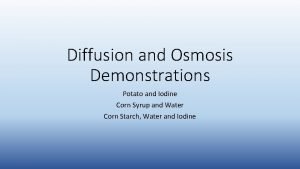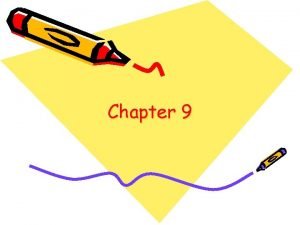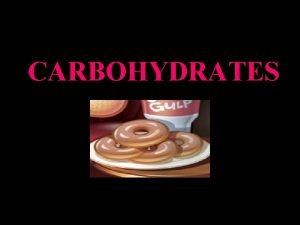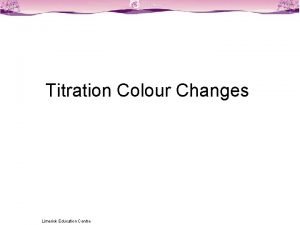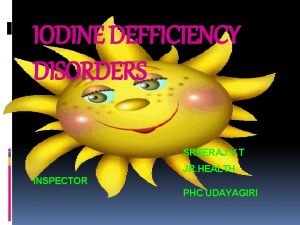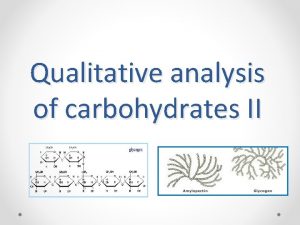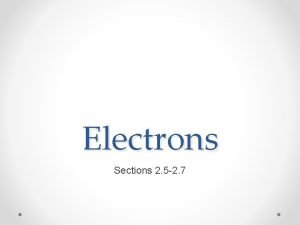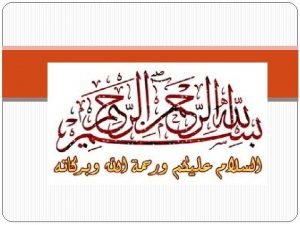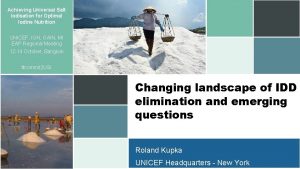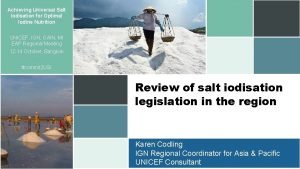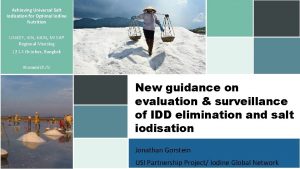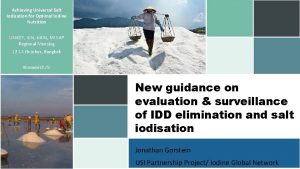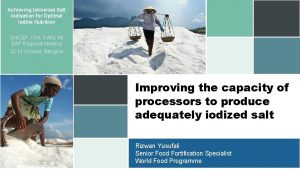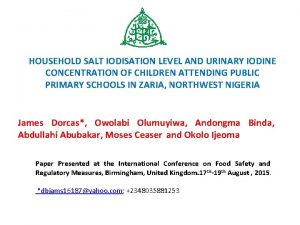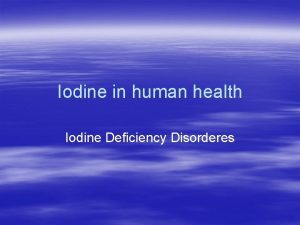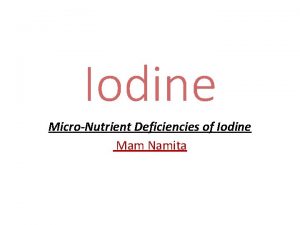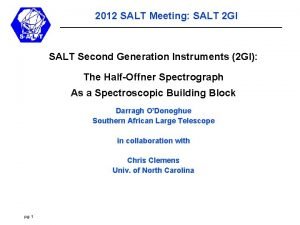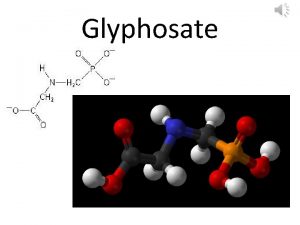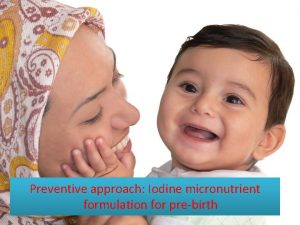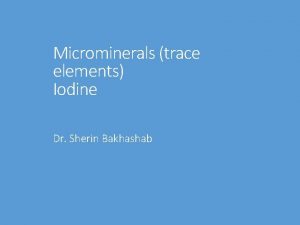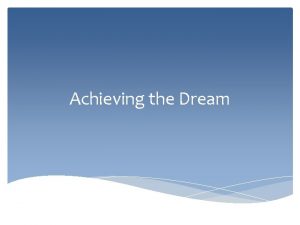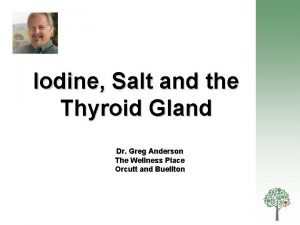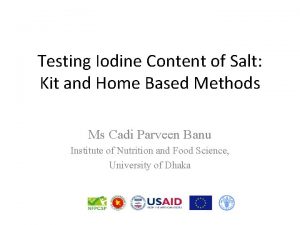Achieving Universal Salt Iodisation for Optimal Iodine Nutrition































- Slides: 31

Achieving Universal Salt Iodisation for Optimal Iodine Nutrition UNICEF, IGN, GAIN, MI EAP Regional Meeting 12 -14 October, Bangkok #commit 2 USI New guidance on evaluation & surveillance of IDD elimination and salt iodisation Jonathan Gorstein USI Partnership Project/ Iodine Global Network

OUTLINE 1. Original paradigm for tracking progress towards USI 2. Interpretation of national survey data on Household Iodized Salt (HHIS) coverage and iodine intake 3. Other issues in evaluation and surveillance 4. Revised paradigm for tracking progress towards USI – improved program guidance 12 -14 October 2015 Bangkok EAP Regional Workshop on ACHIEVING UNIVERSAL SALT IODISATION FOR OPTIMAL IODINE NUTRITION

MONITORING OF USI PROGRAMS Monitoring at strategic points in the value chain Imported Salt Producer Process & Pack Transport, Distribute, Wholesale Retail Sale Household Processed Foods Internal Monitoring External Monitoring Regulatory Monitoring 12 -14 October 2015 Bangkok Surveillance and Evaluation of coverage and impact EAP Regional Workshop on ACHIEVING UNIVERSAL SALT IODISATION FOR OPTIMAL IODINE NUTRITION

MONITORING OF USI PROGRAMS Monitoring at strategic points in the value chain Imported Salt Producer Process & Pack Transport, Distribute, Wholesale Retail Sale Household Processed Foods Internal Monitoring External Monitoring Regulatory Monitoring 12 -14 October 2015 Bangkok Surveillance and Evaluation of coverage and impact EAP Regional Workshop on ACHIEVING UNIVERSAL SALT IODISATION FOR OPTIMAL IODINE NUTRITION

OUTLINE 1. Original paradigm for tracking progress towards USI 2. Interpretation of national survey data on HHIS coverage and iodine intake 3. Other issues in evaluation and surveillance 4. Revised paradigm for tracking progress towards USI – improved program guidance 12 -14 October 2015 Bangkok EAP Regional Workshop on ACHIEVING UNIVERSAL SALT IODISATION FOR OPTIMAL IODINE NUTRITION

SALT IODIZATION- ORIGINAL PARADIGM Coverage of Adequately Iodized Salt at Household (HHIS) Iodine Status (Urinary Iodine – UIC among school-aged children) Program sustainability factors 12 -14 October 2015 Bangkok 6

SALT IODIZATION- ORIGINAL PARADIGM Coverage of Adequately Iodized Salt at Household (HHIS) Original goal of USI : >90% coverage of HHIS Implication: Eliminate IDD Iodine Status (Urinary Iodine – UIC among school-aged children) Program sustainability factors 12 -14 October 2015 Bangkok 7

OUTLINE 1. Original paradigm for tracking progress towards USI 2. Interpretation of national survey data on HHIS coverage and iodine intake 3. Other issues in evaluation and surveillance 4. Revised paradigm for tracking progress towards USI – improved program guidance 12 -14 October 2015 Bangkok EAP Regional Workshop on ACHIEVING UNIVERSAL SALT IODISATION FOR OPTIMAL IODINE NUTRITION

INTERPRETATION OF NATIONAL SURVEY DATA Key questions: 1. Why is there a disconnect between HHIS coverage and iodine status? 2. Based on changing program landscape (Roland), how to improve indicators for program monitoring? 3. How to enhance analysis and presentation of data 12 -14 October 2015 Ref: ICCIDD/GN Global Scorecard (UNICEF and WHO Data) Bangkok EAP Regional Workshop on ACHIEVING UNIVERSAL SALT IODISATION FOR OPTIMAL IODINE NUTRITION

CRITERIA FOR CLASSIFICATION OF IODINE STATUS IN SAC Population IDD Status WHO, UNICEF, ICCIDD (2007) Median value < 20 g/l 20 -49 50 -99 100 -199 200 -299 300 12 -14 October 2015 Bangkok Iodine Status Severe iodine deficiency Moderate iodine deficiency Mild iodine deficiency Ideal iodine intake More than adequate intake Excessive iodine intake EAP Regional Workshop on ACHIEVING UNIVERSAL SALT IODISATION FOR OPTIMAL IODINE NUTRITION

CRITERIA FOR CLASSIFICATION OF IODINE STATUS IN SAC • • In 2013, Zimmerman et al. published data from multiple study sites that measured Urinary Iodine and thyroid function in SAC Multi-center study found no adverse function consequences across the WHO ranges of adequate (UIC range of 100 -199 μg/l ) and more than adequate iodine intake (UIC range of 200 -299 μg/l ). The Study Group suggested adopting the expanded range of optimal UIC levels for school age children (i. e. 100 -299 μg/l) WHO is currently reviewing Zimmerman et al. Thyroglobulin is a sensitive measure of both deficient and excess iodine intakes in children and indicates no adverse effects on thyroid function in the UIC range of 100 -299 μg/l: A UNICEF/ICCIDD Study Group Report. J Clin Endocrin Metab. 2013 12 -14 October 2015 Ref: ICCIDD/GN Global Scorecard (UNICEF and WHO Data) Bangkok EAP Regional Workshop on ACHIEVING UNIVERSAL SALT IODISATION FOR OPTIMAL IODINE NUTRITION

REGIONAL ACHIEVEMENTS: HOUSEHOLD IODISED SALT COVERAGE AND IODINE STATUS 12 -14 October 2015 Bangkok EAP Regional Workshop on ACHIEVING UNIVERSAL SALT IODISATION FOR OPTIMAL IODINE NUTRITION 12

REGIONAL ACHIEVEMENTS: HOUSEHOLD IODISED SALT COVERAGE AND IODINE STATUS Blue box represents USI goal 12 -14 October 2015 Bangkok Blue box represents range of optimal status EAP Regional Workshop on ACHIEVING UNIVERSAL SALT IODISATION FOR OPTIMAL IODINE NUTRITION 13

REGIONAL ACHIEVEMENTS: HOUSEHOLD IODISED SALT COVERAGE AND IODINE STATUS 1/9 countries reached USI goal Blue box represents USI goal 12 -14 October 2015 Bangkok 7/9 counties with ‘optimal iodine status Blue box represents range of optimal status EAP Regional Workshop on ACHIEVING UNIVERSAL SALT IODISATION FOR OPTIMAL IODINE NUTRITION 14

REGIONAL ACHIEVEMENTS: HOUSEHOLD IODISED SALT COVERAGE AND IODINE STATUS 1/9 countries reached both program goals 12 -14 October 2015 Bangkok EAP Regional Workshop on ACHIEVING UNIVERSAL SALT IODISATION FOR OPTIMAL IODINE NUTRITION 15

INTERPRETATION OF NATIONAL SURVEY DATA 1. National data hides sub-national variations 2. Many countries have ‘adequate’ iodine status but <90% HHIS, but there are sub-populations with inadequate iodine status unprotected 3. Other sources of iodine may be contributing to iodine status, in particular iodised salt used in food processing 12 -14 October 2015 Bangkok EAP Regional Workshop on ACHIEVING UNIVERSAL SALT IODISATION FOR OPTIMAL IODINE NUTRITION

IODINE STATUS VS. HHIS: STRATIFICATION BY IODINE CONTENT HHIS coverage National MUIC Iodine Content in HH Salt No Iodine (<5 ppm) Inadequate iodine (5 -15 ppm) Adequate iodine (15 ppm) Nepal 2005/6 Vietnam 2005/6 58% 93% 188 ug/L 130 ug/L Median UIC SAC (ug/L) 71 78 131 136 252 155 • MUIC of SAC is “optimal” in both countries although Nepal only had HHIS of 58% • Stratification of MUIC by salt iodine content indicates HH’s consuming noniodized salt were deficient and those consuming inadequately iodized salt had lower MUIC than those consuming adequately iodized salt Refs: Nepal: National Micronutrient Survey 2005/6; Viet Nam: National IDD Survey 2005/6 12 -14 October 2015 Bangkok EAP Regional Workshop on ACHIEVING UNIVERSAL SALT IODISATION FOR OPTIMAL IODINE NUTRITION

PHILIPPINES: INEQUITY IN IODINE STATUS AND HHIS Blue box represents range of optimal status 12 -14 October 2015 Bangkok Blue box represents range of optimal status EAP Regional Workshop on ACHIEVING UNIVERSAL SALT IODISATION FOR OPTIMAL IODINE NUTRITION 18

ASSESS OTHER SOURCES OF IODINE IN THE DIET - INDONESIA 100 90 80 70 60 50 7 6 6 6 5 5 5 3 13 12 12 12 8 8 15 15 15 16 16 17 17 6 7 7 6 17 22 20 20 19 6 5 10 9 7 7 90 34 32 30 87 88 88 9 13 9 9 8 11 86 87 85 5 12 10 9 83 11 13 15 18 11 14 78 11 78 79 80 77 78 12 12 11 75 75 72 74 73 72 71 8 70 70 68 67 67 68 68 13 62 16 55 50 40 30 20 10 74 ( 11 n= (n 27) = 19 12 ( 8) 51 n= (n 32) 31 =2 (n 22) 81 =2 (n 85) 53 =1 (n 00) 13 =1 (n 83) = 71 26 ( 2) 16 n= (n 51) 14 =4 (n 39) 15 =1 (n 53) 36 =2 (n 08) 18 =9 (n 24) 52 =3 ( 88 32 n= ) (n 444 = ) 73 22 2 2 ( 35 n= ) (n 451 =2 ) 76 39 ( 0) 21 n= (n 72) 12 =1 ( 76 33 n= ) (n 619 = ) 61 18 3 9 (n ) 63 =1 9 (n 6) = 75 25 ( 2) 72 n= (n 30) 64 =2 (n 32) = 17 19 ( 2) 34 n= (n 65) = 91 29 ( 5) 94 n= (n 78) = 62 16 (n 4) 82 =2 (n 5) =8 3) 0 Province % Salt % Noodle % Water • Indonesia analysis has revealed that, on average, 75% of total iodine intake is from HHIS, while 15% is from iodized salt used in instant noodles and 10% is from iodine in drinking water, but some areas where water is a major source Refs: 2013 Indonesia Riskedas (Litbang Kesehatan) 12 -14 October 2015 Bangkok EAP Regional Workshop on ACHIEVING UNIVERSAL SALT IODISATION FOR OPTIMAL IODINE NUTRITION

OUTLINE 1. Original paradigm for tracking progress towards USI 2. Interpretation of national survey data on HHIS coverage and iodine intake 3. Other issues in evaluation and surveillance 4. Revised paradigm for tracking progress towards USI – improved program guidance 12 -14 October 2015 Bangkok EAP Regional Workshop on ACHIEVING UNIVERSAL SALT IODISATION FOR OPTIMAL IODINE NUTRITION

PERFORMANCE OF RTK TO ASSESS SALT WITH ANY IODINE 12 -14 October 2015 Bangkok EAP Regional Workshop on ACHIEVING UNIVERSAL SALT IODISATION FOR OPTIMAL IODINE NUTRITION

PERFORMANCE OF RTK TO ASSESS SALT WITH ADEQUATE IODINE 12 -14 October 2015 Bangkok EAP Regional Workshop on ACHIEVING UNIVERSAL SALT IODISATION FOR OPTIMAL IODINE NUTRITION

USE OF RTK TO ASSESS IODINE IN SALT • RTK only appropriate to distinguish salt with no iodine from salt without iodine • To measure content of iodine in salt, quantitative tools are required • New tools are available in addition to titration - I-Reader and the i. Check —appear to be the most reliable in terms of analytical performance (Comparative Validation of Five Quantitative Rapid Test Kits for the Analysis of Salt Iodine Content: Laboratory Performance, User-and Field. Friendliness) 12 -14 October 2015 Bangkok EAP Regional Workshop on ACHIEVING UNIVERSAL SALT IODISATION FOR OPTIMAL IODINE NUTRITION

USE MEDIANS TO PRESENT UIC DATA • In the presentation of UIC data, only medians are appropriate • Cut-off points are based on population classification, so median UIC in SAC < 100 ug/l reflects sub-optimal iodine status, but should not be used to estimate the proportion with sub-optimal intake • Daily variation that will result in many individual days when a UIC value will be less than adequate • Even in populations in which iodized salt ensures adequate thyroid stores, there will be individuals with a UIC<100 mg/L on the day of the survey, but are not truly iodine deficient 12 -14 October 2015 Bangkok EAP Regional Workshop on ACHIEVING UNIVERSAL SALT IODISATION FOR OPTIMAL IODINE NUTRITION

USE MEDIANS TO PRESENT UIC DATA • An example from Switzerland: – Median UIC of 120 ug/l and TGR < 3% – Population classified as ‘optimal’ – 36% of the values < 100 ug/L – but this not indicate that one third of the population has sub-optimal intakes 12 -14 October 2015 Bangkok EAP Regional Workshop on ACHIEVING UNIVERSAL SALT IODISATION FOR OPTIMAL IODINE NUTRITION

OUTLINE 1. Original paradigm for tracking progress towards USI 2. Interpretation of national survey data on HHIS coverage and iodine intake 3. Other issues in evaluation and surveillance 4. Revised paradigm for tracking progress towards USI – improved program guidance 12 -14 October 2015 Bangkok EAP Regional Workshop on ACHIEVING UNIVERSAL SALT IODISATION FOR OPTIMAL IODINE NUTRITION

SALT IODIZATION- ORIGINAL PARADIGM Coverage of Adequately Iodized Salt at Household (HHIS) Iodine Status (Urinary Iodine – UIC among school-aged children) Program sustainability factors 12 -14 October 2015 Bangkok 27

NEW PARADIGM: OPTIMIZE IODINE NUTRITION THROUGH DIFFERENT DIETARY SOURCES OF IODINE Iodized Salt in Processed Foods & Condiments Household Adequately Iodized Salt School age vs pregnant National vs subnational fd National Iodine Status (Urinary Iodine) Other MN interventions (home fortification, maternal supplements. . ) 12 -14 October 2015 Bangkok Iodine in soil & water (affects iodine in local drinking water & agricultural products) Program sustainability factors 28

IMPROVED PROGRAM MONITORING 1. Iodine intake • Measure major sources of iodine in the diet (HH, PF) • Use titration to assess actual iodine content in salt 2. Iodine status in the population (UIC) • Focus on WRA and PW • Presentation of Median only, for now 3. Link monitoring of USI to sodium reduction • Measure salt (per capita consumption) and sources in the diet • Measure sodium from same urine panel as iodine 4. Data interpretation • Sub-group analysis by SES, poverty risk, HH salt iodine content to identify program challenges • Use of data (iodine intake, iodine status , salt consumption) to adjust iodine standards 12 -14 October 2015 Bangkok EAP Regional Workshop on ACHIEVING UNIVERSAL SALT IODISATION FOR OPTIMAL IODINE NUTRITION

USE OF PROGRAM DATA TO REVISE IODINE STANDARDS AND IMPROVE PROGRAMS Start up program: set approximate iodization level Iodization level Assess Household Iodized Salt Make sure the program is in place and scaled up , then assess coverage and then iodine status Feedback to adjust iodization level (every 5 -10 yrs) If MUIC >300 --> reduce If MUIC <100 --> increase or focus on program strengthening Assess Iodized salt in Processed Foods Measure Iodine status (Urinary Iodine) School children 100 - 299 ug/L Women of Reproductive age 100 -199 ug/L • • Make sure both groups have adequate iodine If not, then consider modifying standards 30 12 -14 October 2015 Bangkok EAP Regional Workshop on ACHIEVING UNIVERSAL SALT IODISATION FOR OPTIMAL IODINE NUTRITION

Thank you! #commit 2 USI
 Iodine deficiency
Iodine deficiency Iodine functions
Iodine functions Heyoka dns
Heyoka dns Cellulose in iodine test
Cellulose in iodine test What is the show cesium and iodine love watching
What is the show cesium and iodine love watching Redox volumetric analysis
Redox volumetric analysis Pre natal sex
Pre natal sex Orbital diagram for ca
Orbital diagram for ca Swollen thyrpid
Swollen thyrpid Data exfiltration over dns
Data exfiltration over dns Iodine deficiency goiter
Iodine deficiency goiter Iodine fuming chamber
Iodine fuming chamber Iodine fuming definition
Iodine fuming definition Iodine fuming
Iodine fuming Disadvantages of iodine fuming
Disadvantages of iodine fuming Partition coefficient of iodine
Partition coefficient of iodine Iodine clock reaction lab report answers
Iodine clock reaction lab report answers Qualitative analysis of carbohydrates
Qualitative analysis of carbohydrates Iodine deficiency
Iodine deficiency Study of fingerprints is known as
Study of fingerprints is known as Half life calculation
Half life calculation Chlorine, iodine, and _____ make up the halogen triad.
Chlorine, iodine, and _____ make up the halogen triad. Crystal violet iodine alcohol safranin
Crystal violet iodine alcohol safranin Potato and iodine diffusion experiment
Potato and iodine diffusion experiment Iodine is an example of a/an_____.
Iodine is an example of a/an_____. Information about carbohydrates
Information about carbohydrates Phenolphthalein titration
Phenolphthalein titration What is cause of death?
What is cause of death? I 125 half life
I 125 half life Iodine test principle
Iodine test principle 1s 22 s22 p63
1s 22 s22 p63 Tincture of orange is prepared by which process
Tincture of orange is prepared by which process
